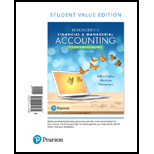
Concept explainers
(1)
Allowance method
It is a method for accounting bad debt expense, where uncollectible accounts receivables are estimated and recorded at the end of particular period. Under this method,
Aging of receivables method:
A method of determining the estimated uncollectible receivables, based on the age of individual accounts receivable is known as aging of receivables method.
To journalize: The entry for recording bad debts expense for the year 2018, using the aging of receivables method.
(2)
To prepare: A T-accountfor allowance for bad debts to determine its ending balance.
Want to see the full answer?
Check out a sample textbook solution
Chapter 8 Solutions
Horngren's Financial & Managerial Accounting, The Managerial Chapters, Student Value Edition (6th Edition)
- Can you explain the correct methodology to solve this general accounting problem?arrow_forwardPlease help me solve this general accounting question using the right accounting principles.arrow_forwardSuppose during 2025 that Federal Express reported the following information (in millions): net sales of $82,500 and net income of $185. Its balance sheet also showed total assets at the beginning of the year of $27,000 and total assets at the end of the year of $23,000. Calculate the asset turnover and return on assets. (Round answers to 2 decimal places, e.g. 6.25 or 6.25%.) Asset turnover Return on assets times %arrow_forward
- The shareholders of Barley Corporation have voted in favor of a buyout offer from Wheat Corporation. Information about each firm is given here: Barley Wheat Price/earnings ratio 13.5 21 Shares outstanding 90,000 210,000 Earnings $180,000 $810,000 Barley shareholders will receive one share of Wheat stock for every three shares they hold of Barley. Required What will the EPS of Wheat be after the merger? What will be the P/E ratio if the NPV of the acquisition is 0? What must Wheat feel is the value of the synergy between these two firms? Explain how your answer can be reconciled with the decision to go ahead with the takeover?arrow_forwardI am trying to find the accurate solution to this general accounting problem with the correct explanation.arrow_forwardPlease provide the answer to this general accounting question with proper steps.arrow_forward
- Respond to jane Plant assets of DTPW are essential to the County’s transportation services and infrastructure. These assets consist of physical, long-term resources including our vast Metrorail and Metromover systems, maintenance facilities, administrative buildings, bus depots, and train stations. DTPW depends greatly on machinery such as fare collection machines, elevators, escalators, signaling devices, and track systems which are necessary to ensure that our daily operations go off without a hitch. For example, our buses and service trucks are regarded as plant assets since they help the department fulfill its goal of providing dependable and effective transportation across the County. These assets are valuable in addition to being physically noteworthy because they reflect large investments made to preserve accessibility, safety, and public transportation. For long-term planning and financial reporting, these assets have to be properly managed and their depreciation tracked.…arrow_forwardCan you solve this general accounting question with accurate accounting calculations?arrow_forwardPlease explain the correct approach for solving this general accounting question.arrow_forward

 AccountingAccountingISBN:9781337272094Author:WARREN, Carl S., Reeve, James M., Duchac, Jonathan E.Publisher:Cengage Learning,
AccountingAccountingISBN:9781337272094Author:WARREN, Carl S., Reeve, James M., Duchac, Jonathan E.Publisher:Cengage Learning, Accounting Information SystemsAccountingISBN:9781337619202Author:Hall, James A.Publisher:Cengage Learning,
Accounting Information SystemsAccountingISBN:9781337619202Author:Hall, James A.Publisher:Cengage Learning, Horngren's Cost Accounting: A Managerial Emphasis...AccountingISBN:9780134475585Author:Srikant M. Datar, Madhav V. RajanPublisher:PEARSON
Horngren's Cost Accounting: A Managerial Emphasis...AccountingISBN:9780134475585Author:Srikant M. Datar, Madhav V. RajanPublisher:PEARSON Intermediate AccountingAccountingISBN:9781259722660Author:J. David Spiceland, Mark W. Nelson, Wayne M ThomasPublisher:McGraw-Hill Education
Intermediate AccountingAccountingISBN:9781259722660Author:J. David Spiceland, Mark W. Nelson, Wayne M ThomasPublisher:McGraw-Hill Education Financial and Managerial AccountingAccountingISBN:9781259726705Author:John J Wild, Ken W. Shaw, Barbara Chiappetta Fundamental Accounting PrinciplesPublisher:McGraw-Hill Education
Financial and Managerial AccountingAccountingISBN:9781259726705Author:John J Wild, Ken W. Shaw, Barbara Chiappetta Fundamental Accounting PrinciplesPublisher:McGraw-Hill Education





